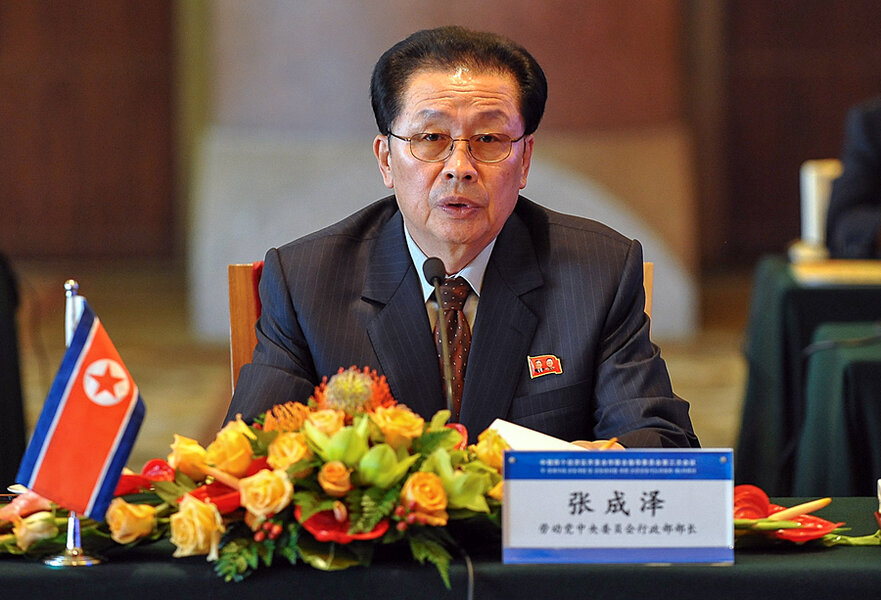North Korea's public purge may have hinged on economic plans
Loading...
| Seoul, South Korea
North Korean state-run television today aired a first: the image of uniformed guards pulling the former power behind the North Korean throne out of a meeting at which he was stripped of all his posts.
The broadcast confirms that Kim Jong-un’s uncle Jang Song-thaek was removed from his positions in the highest-level leadership change since the young Mr. Kim came to power. The question remains what Mr. Jang did to suffer such total disgrace after having served as the right-hand man to Mr. Kim for nearly two years after the death of Kim’s father, Kim Jong-il. Although numerous figures have been purged in North Korea, none has appeared in a photograph on state TV being dragged from a Workers’ Party Congress in the arms of uniformed guards at the moment of his fall from grace.
Denounced for crimes ranging from “anti-state” activity to corruption, Jang is believed to have been a divisive figure whose passing from the scene may do as much to solidify as to undermine the power of Kim Jong-un. Jang’s worst offense appears to have been that he was at odds with military leaders on reform of the North’s crumbling economy.
An economic reformer?
Jang was “the de facto chairman of the capitalist wing of North Korea,” says Michel Breen, a businessman who has visited Pyongyang a number of times and wrote a brief biography of Kim Jong-il, Kim's late father. “He was in charge of moves toward capitalism and reviving the economy.”
Jang’s inclination to implant capitalist styles on North Korea’s state trading companies is seen as one of the principal factors behind a military-led drive to eradicate him and his influence.
“The state trading companies were the conglomerates that kept the elite going,” says Mr. Breen. “They operated capitalist state businesses.” Now, says Breen, some of the state companies over which Jang held sway “may find themselves high and dry.”
The decision to get rid of Jang may not have an immediate effect on South Korean companies producing light industrial products at the jointly operated Gaesong Industrial Complex, just above the line with South Korea, but analysts believe his encouragement of that opportunity for North-South cooperation may have been a factor in his fall.
“Gaesong is related to what is happening,” says Lee Chang-choon, a former South Korean diplomat who once served as ambassador at the International Atomic Energy Agency in Vienna. “The military is said to have opposed the reopening of the Gaesong complex” – closed for three months earlier this year during a crisis that seemed at one point to bring the two Koreas to the brink of open conflict.
Motive for the purge
Jang’s downfall raises contrary views and theories about what really happened – and what’s likely next. One view is that Kim Jong-un decided to eliminate Jang in order to remove a threat and consolidate power.
The polar-opposite theory is that Jang’s demise leaves Kim himself open to a power grab by the same clique of military leaders who hated Jang’s rise to such seeming omnipotence. “Jang was Kim’s shield for two years,” says Kim Ki-sam, a former official at South Korea’s National Intelligence Service, now living in the United States. “There are thousands of snakes around Kim Jong-un.”
Regardless of which theory is correct, the North Korean ruling elite is now seen as in such turmoil that the leadership will not be able to deal effectively with the outside world for the foreseeable future.
“The question is who controls North Korea,” says Lakhvinder Singh, a professor at the Institute for Far Eastern Studies in Seoul who has been observing the Byzantine intricacies of North Korean politics and diplomacy for the past 15 years. “For now, the military has succeeded.”
Under the circumstances, North Korea is likely to be too deeply involved in internal problems either to engage in diplomacy on its nuclear program or to engage in more than rhetorical threats against South Korea.
“North Korea will be very nervous and tense,” says Choi Jin-wook, North Korea expert at the Korea Institute of National Unification. “Kim Jong-un himself may be in danger. North Korea will not do anything.”
In the meantime, the nature of Jang’s downfall, as captured in the photograph distributed by North Korean state TV, “is a warning for everyone not to do anything.”





